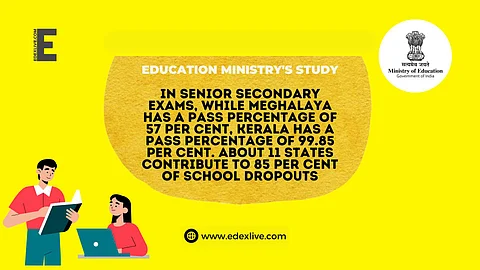

A study by the Ministry of Education observed that large differences in performance of students from various boards, significant variation in pass percentages and no level playing field for students in terms of the standard are among the challenges in the assessment of Classes X and XII exam results, as stated by a report by PTI.
Further, the assessment has also pointed out that the top five boards (Uttar Pradesh, Central Board of Secondary Education or CBSE, Maharashtra, Bihar and West Bengal) cover about 50 per cent of students and the rest 50 per cent of students are enrolled in 55 boards across the country. Additionally, it noted that the deviation in performance might be due to different patterns followed by boards and the convergence of secondary and higher secondary boards into a single board in a state can help students. The different syllabi followed by boards have created barriers to national-level entrance tests, it added.
As per School Education Secretary, Sanjay Kumar, the difference between pass percentages of various states has led the education ministry to now look at standardising the assessment pattern for all 60 school boards across various states in the country. Currently, there are three central boards in India — the Central Board of Secondary Education (CBSE), the Council for the Indian School Certificate Examinations (CISCE) and the National Institute of Open Schooling (NIOS). Apart from these, various states have their own state boards, taking the total number of school boards to 60.
Noting that the pass percentages vary significantly among boards, the study points out that in senior secondary exams, while Meghalaya has a pass percentage of 57 per cent, Kerala has a pass percentage of 99.85 per cent. It also noted that 11 states contribute to 85 per cent of school dropouts. These states are Uttar Pradesh, Bihar, Madhya Pradesh, Gujarat, Tamil Nadu, Rajasthan, Karnataka, Assam, West Bengal, Haryana and Chhattisgarh.
Among possible causes for higher failure rates in state, boards pointed out in the report include less number of trained teachers and teachers per school. This contributes to a low Gross Enrolment Ratio (GER) and also affects India's overall rank in global indices.
Report analysis
The report analysed the Class X and XII results for state boards of Andhra Pradesh, Assam, Karnataka, Kerala, Manipur, Odisha, West Bengal and Telangana to understand the variation in results for different state boards. The report has also recommended that state boards may converge the Science syllabus with the central boards so that students have a level playing field for common exams like Joint Entrance Examination (JEE) and National Eligibility cum Entrance Test (NEET). The other reason behind this standardisation attempt is to contain the dropouts at the level of Class X.
Giving more details, the report said, "Thirty-five lakh students of class 10 are not reaching class 11, 27.5 lakh students are failing and 7.5 lakh students are not appearing for the exam." About 11 states, including Uttar Pradesh, Bihar, Madhya Pradesh, Gujarat, Tamil Nadu, Rajasthan, Karnataka, Assam, West Bengal, Haryana and Chhattisgarh, contribute the maximum 85 per cent of the dropouts, it added.
"Mapping of failing students (around 46 lakh) of regular state boards with open boards and exchange of information can help in tracking and retaining students in the education system for a longer period. Presently, only 10 lakh students are registering through open schools," the report further said. Similarly, (around 12 lakh) students registered but not appearing can be mapped with the skill development department for tracking and training them, it added, as stated in a report by PTI.
